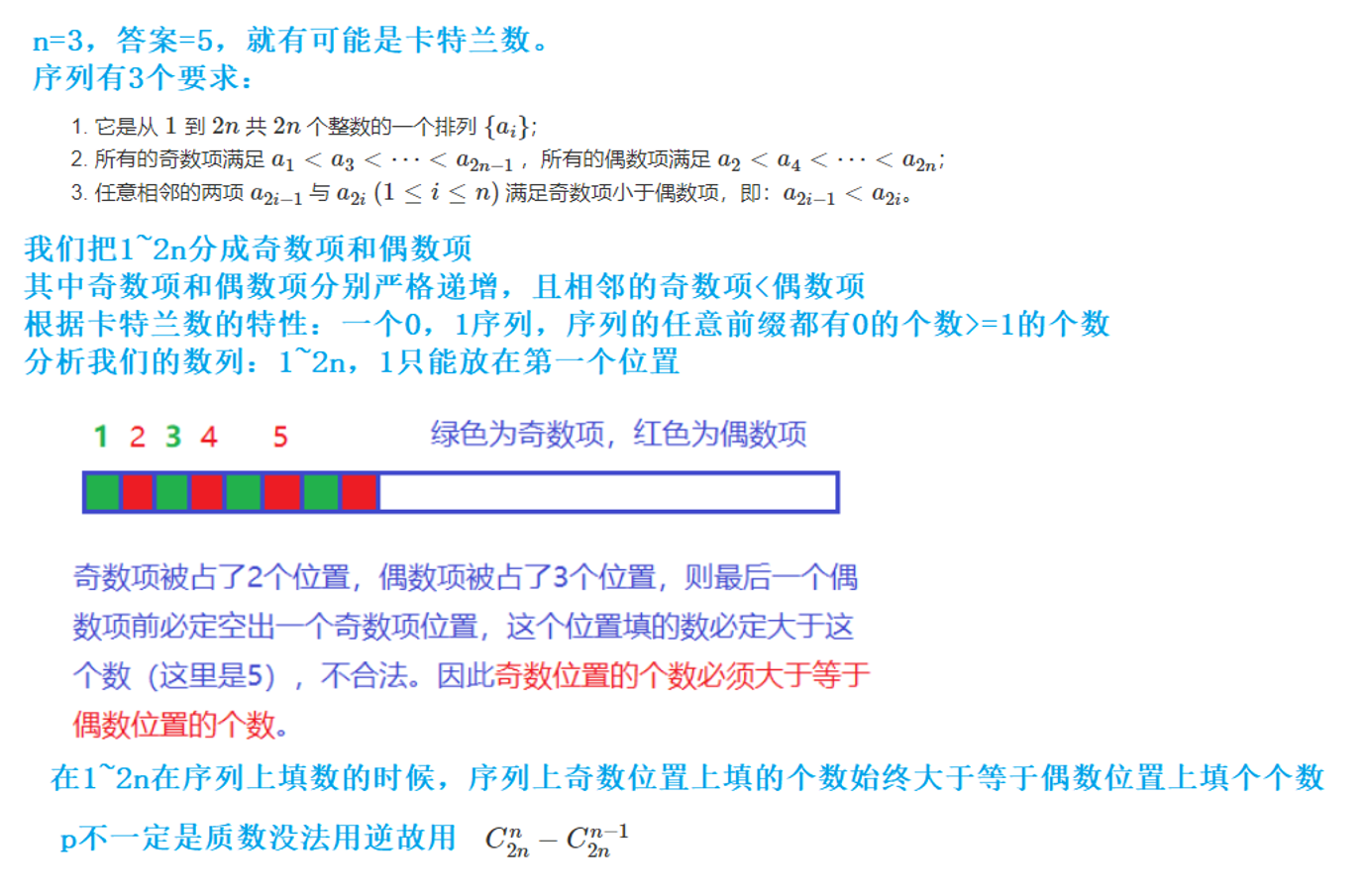You can not select more than 25 topics
Topics must start with a letter or number, can include dashes ('-') and can be up to 35 characters long.
3.3 KiB
3.3 KiB
一、题目描述
我们称一个长度为 2n 的数列是有趣的,当且仅当该数列满足以下三个条件:
-
它是从
1到2n共2n个整数的一个排列{a_i} -
所有的 奇数项 满足
a_1<a_3<⋯<a_{2n−1},所有的 偶数项 满足a_2<a_4<⋯<a_{2n} -
任意相邻的两项
a_{2i−1}与a_{2i}(1≤i≤n)满足奇数项小于偶数项,即:a_{2i−1}<a_{2i}
任务是:对于给定的 n,请求出有多少个不同的长度为 2n 的有趣的数列。
因为最后的答案可能很大,所以只要求输出答案 mod P的值。
输入格式
只包含用空格隔开的两个整数 n 和 P。
输出格式
仅含一个整数,表示不同的长度为 2n 的有趣的数列个数 mod P 的值。
数据范围
1≤n≤10^6,2≤P≤10^9
输入样例
3 10
输出样例:
5
样例解释
对应的 5 个有趣的数列分别为 \{1,2,3,4,5,6\},\{1,2,3,5,4,6\},\{1,3,2,4,5,6\},\{1,3,2,5,4,6\},\{1,4,2,5,3,6\}。
二、解题思路
我们要有这种直觉:一旦发现输入是3,输出是5,很可能就是 卡特兰数。关于卡特兰数的讲解可以参考:网址。
如何判断某个问题是不是卡特兰数呢?一般由两种方式:
- ① 能得到公式:
\large f(n)=f(0) \times f(n-1) + f(1) \times f(n-2) + ... +f(n-1)\times f(0)
解释:联想一下嘉持老师的画二叉树,就是向左子树分配
i个节点,那么向右子树就分配n-i-1个节点,因为根点了一个节点。
- ② 能挖掘出如下性质:任意前缀中,某种东西的数量 ≥ 另一种东西数量。

组合数等于三个阶乘相乘除,因此我们求出各个阶乘的质因数分解,就能得到组合数的模
组合数等于三个阶乘相乘除,因此我们求出各个阶乘的质因数分解,就能得到组合数的模p后大小。
三、实现代码
#include <bits/stdc++.h>
using namespace std;
#define int long long
#define endl "\n"
const int N = 2000010;
int n, mod;
int primes[N], cnt;
bool st[N];
void get_primes(int n) {
for (int i = 2; i <= n; i++) {
if (!st[i]) primes[cnt++] = i;
for (int j = 0; primes[j] * i <= n; j++) {
st[i * primes[j]] = true;
if (i % primes[j] == 0) break;
}
}
}
int qmi(int a, int k) {
int res = 1;
while (k) {
if (k & 1) res = res * a % mod;
a = a * a % mod;
k >>= 1;
}
return res;
}
int get(int n, int p) {
int s = 0;
while (n) {
s += n / p;
n /= p;
}
return s;
}
int C(int a, int b) {
int res = 1;
for (int i = 0; i < cnt; i++) {
int p = primes[i];
int s = get(a, p) - get(b, p) - get(a - b, p);
res = res * qmi(p, s) % mod;
}
return res;
}
signed main() {
cin >> n >> mod;
get_primes(n * 2);
cout << (C(n * 2, n) - C(n * 2, n - 1) + mod) % mod << endl;
}